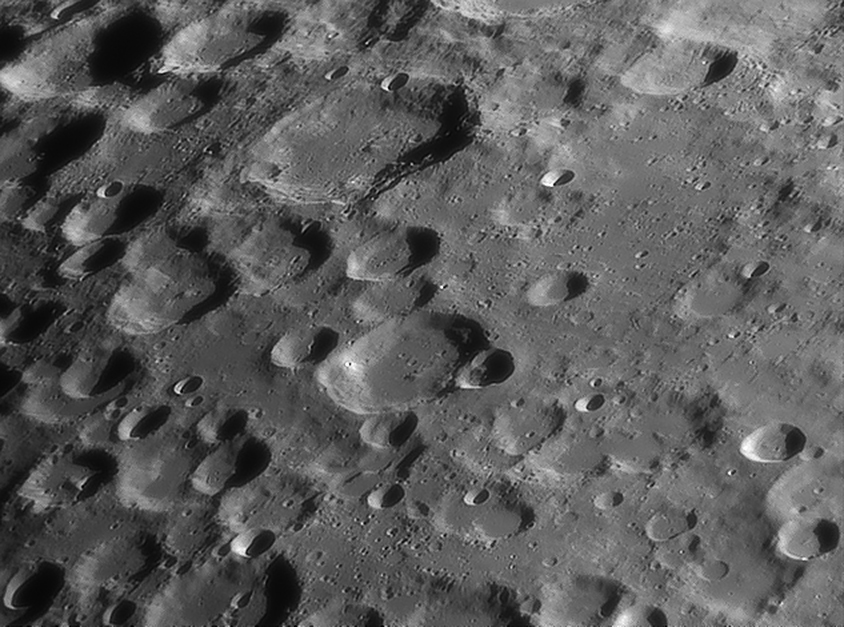
image by Bob Pilz
In the 1850s, Julius Schmidt - arguably the greatest lunar observer who ever hovered over an eyepiece - measured the depth of Curtius 80 times. I don’t know what his obsession was, pehaps he couldn’t believe his highest determination of 6.7 km - I know that I can’t believe it. I have a different obsession when I look at Bob’s excellent image of Curtius (top, slightly left of center in this south up view), Zach (below center with tiny central peak) and their surroundings. I see an old heavily cratered surface with the left side of hundreds of small crater pits catching the brightness of a setting Sun. But these pits are not everywhere. There are many areas where none are visible at this resolution. Look, for example, at the unnamed crater near the center front of the image. Its left rim is mostly missing where it overlaps a somewhat larger and older crater. But the floor of the smaller one appears as an unblemished smoothness, while that of the overlapped crater is pitted and textured like most of the other surfaces in this area. Look around and notice other smooth floors and spaces between craters. Of course, if you look at spacecraft images, you will see some impact pits on these smooth spots, but far fewer than on adjacent terrains. A smooth surface is a young surface. Some material must covers the small pits that must have once existed. The standard answer is that this smoothness must be fluidized ejecta from the formation of Orientale. I say that that interpretation is just as faulty as Schmidt’s 6.7 km height estimate. It would be impossible for basin ejecta to just fill some spots and leave adjacent depressions alone. We don’t know what this smooth material is - it isn’t mare basalt because it isn’t dark under hiigh Sun, and spectrally it looks like normal highlands rocks. But it is undeniably young, and is smooth - if it isn’t some sort of unsampled volcanic flow it is something even more remarkable. It is time for lunar scientists to wake up to its existence!
Technical Details:
10 Dec, 2006, ~08:58 UT. 200mm f/6 Newtonian reflector, Televue 3x Barlow , DMK 21BF04 B/W camera, ‘Blue’ IR-block filter, .20 arcsec/pixel; 30 fps, 1/50 sec, 600/9000 frames stacked. Processed in Registax, ImagesPlus, PS CS.
Related Links:
Rükl chart 73
Bob’s website
Yesterday's LPOD: Deep Black & a Little White
Tomorrow's LPOD: Where People Make Moons
COMMENTS?
Register, Log in, and join in the comments.



